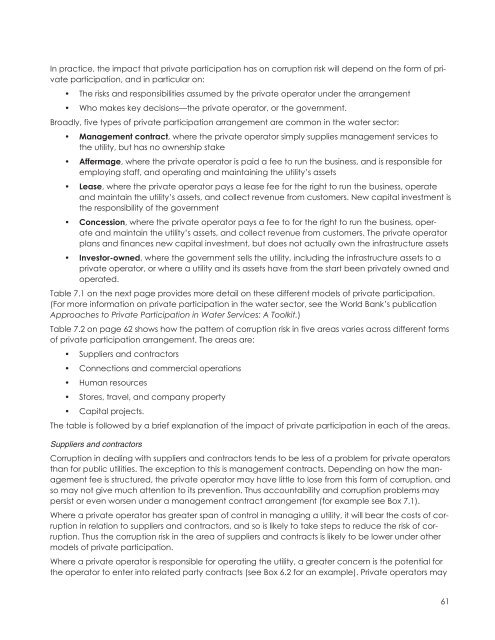A Sourcebook - UN-Water
A Sourcebook - UN-Water
A Sourcebook - UN-Water
You also want an ePaper? Increase the reach of your titles
YUMPU automatically turns print PDFs into web optimized ePapers that Google loves.
In practice, the impact that private participation has on corruption risk will depend on the form of private<br />
participation, and in particular on:<br />
• The risks and responsibilities assumed by the private operator under the arrangement<br />
• Who makes key decisions—the private operator, or the government.<br />
Broadly, five types of private participation arrangement are common in the water sector:<br />
• M anagement contract, where the private operator simply supplies management services to<br />
the utility, but has no ownership stake<br />
• A ffermage, where the private operator is paid a fee to run the business, and is responsible for<br />
employing staff, and operating and maintaining the utility’s assets<br />
• L ease, where the private operator pays a lease fee for the right to run the business, operate<br />
and maintain the utility’s assets, and collect revenue from customers. New capital investment is<br />
the responsibility of the government<br />
• Concession, where the private operator pays a fee to for the right to run the business, operate<br />
and maintain the utility’s assets, and collect revenue from customers. The private operator<br />
plans and finances new capital investment, but does not actually own the infrastructure assets<br />
• I nvestor-owned, where the government sells the utility, including the infrastructure assets to a<br />
private operator, or where a utility and its assets have from the start been privately owned and<br />
operated.<br />
Table 7.1 on the next page provides more detail on these different models of private participation.<br />
(For more information on private participation in the water sector, see the World Bank’s publication<br />
Approaches to Private Participation in <strong>Water</strong> Services: A Toolkit.)<br />
Table 7.2 on page 62 shows how the pattern of corruption risk in five areas varies across different forms<br />
of private participation arrangement. The areas are:<br />
• Suppliers and contractors<br />
• Connections and commercial operations<br />
• Human resources<br />
• Stores, travel, and company property<br />
• Capital projects.<br />
The table is followed by a brief explanation of the impact of private participation in each of the areas.<br />
Suppliers and contractors<br />
Corruption in dealing with suppliers and contractors tends to be less of a problem for private operators<br />
than for public utilities. The exception to this is management contracts. Depending on how the management<br />
fee is structured, the private operator may have little to lose from this form of corruption, and<br />
so may not give much attention to its prevention. Thus accountability and corruption problems may<br />
persist or even worsen under a management contract arrangement (for example see Box 7.1).<br />
Where a private operator has greater span of control in managing a utility, it will bear the costs of corruption<br />
in relation to suppliers and contractors, and so is likely to take steps to reduce the risk of corruption.<br />
Thus the corruption risk in the area of suppliers and contracts is likely to be lower under other<br />
models of private participation.<br />
Where a private operator is responsible for operating the utility, a greater concern is the potential for<br />
the operator to enter into related party contracts (see Box 6.2 for an example). Private operators may<br />
61
















